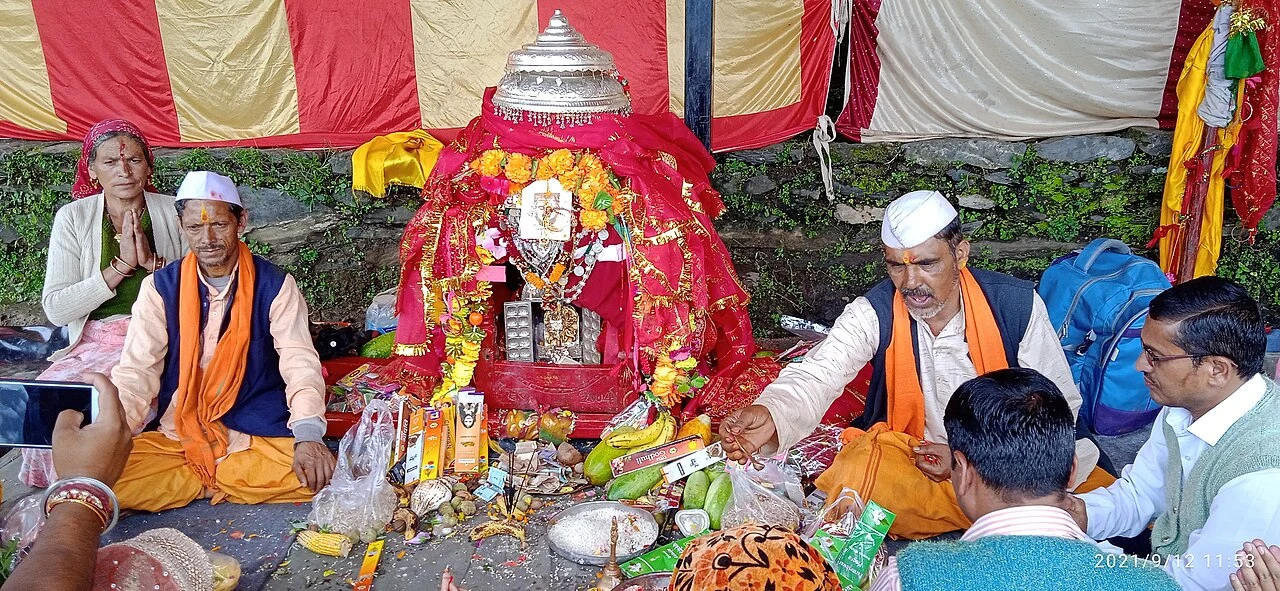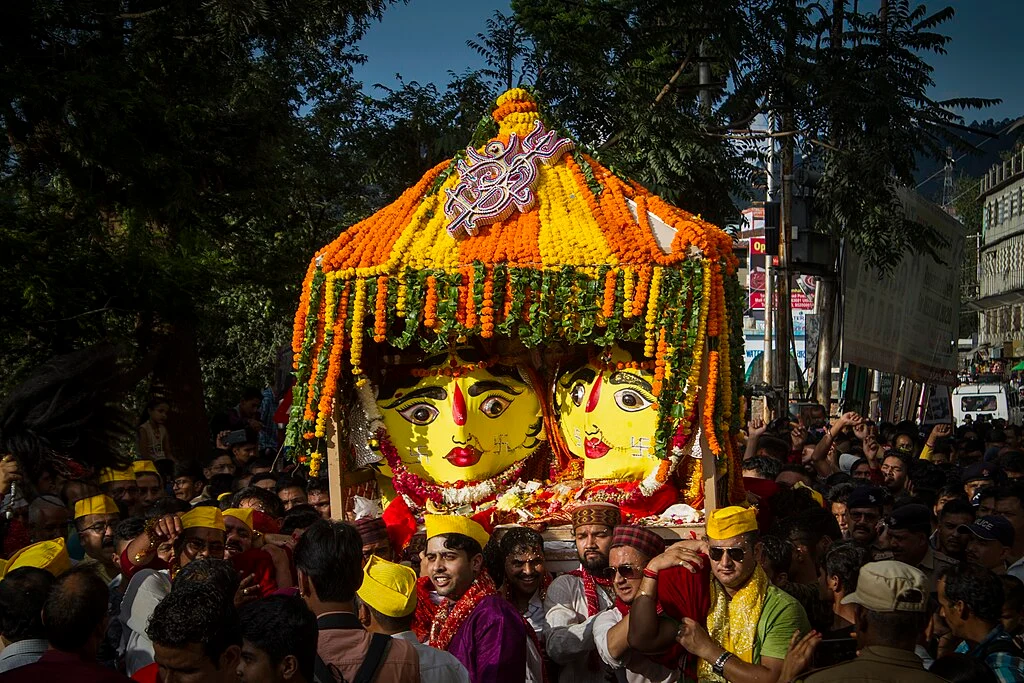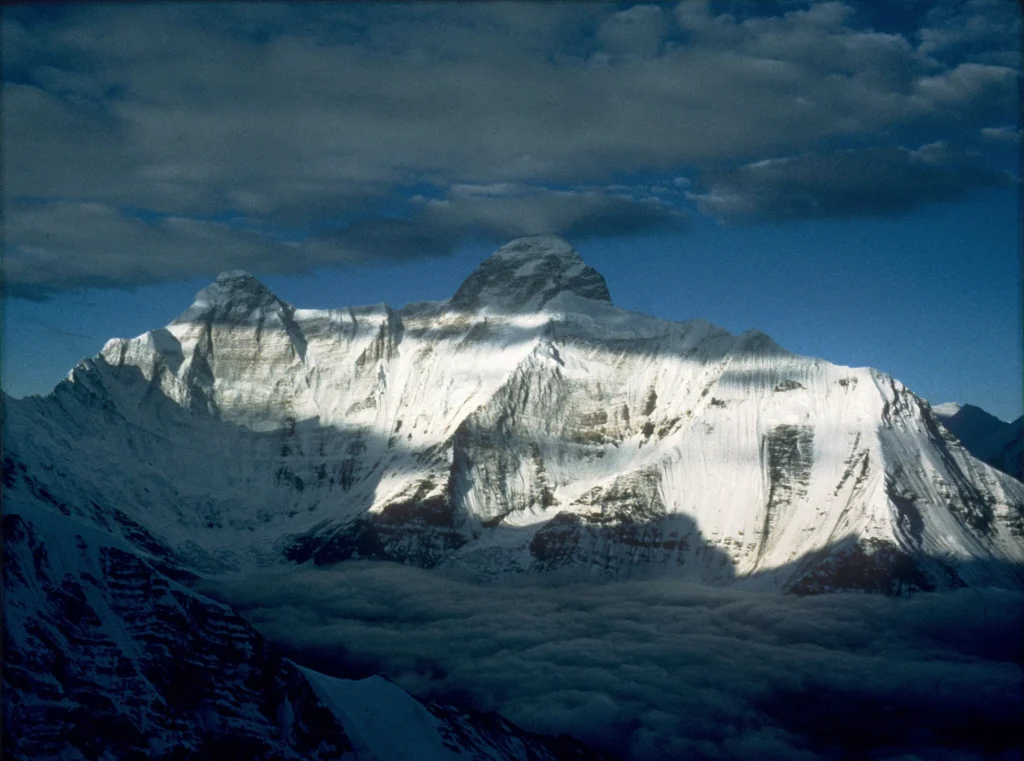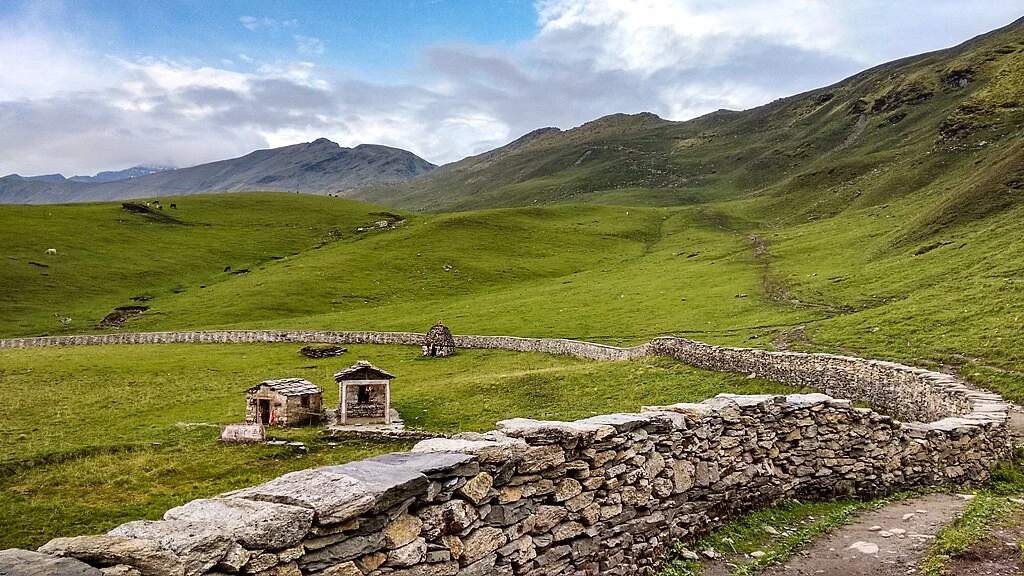Nanda Devi Raj Jat Yatra is held once every 12 years, where Hindu devotees participate in a 3-week-long holy procession in Uttarakhand. It starts from the Nauti Village in Chamoli District and ends at Homkund, near Roopkund Lake. The pilgrimage route spans over 280 km, passing through remote villages, alpine meadows, and rough Himalayan terrain.
Famous as “Himalayan Kumbh,” the journey follows the path of Goddess Nanda Devi from her maternal home to unite with Lord Shiva. It is led by a four-horned ram, followed by devotees carrying a doli barefoot and singing folk songs to give the goddess a sacred farewell. The yatra is organized during the monsoon months of August and September, as per the Hindu calendar.
Want to witness this divine procession in 2026? Scroll down to learn more about its history, complete route, and how you can prepare for this sacred journey.
History of Nanda Devi Raj Jaat

It is believed that the Nanda Devi Raj Jaat Yatra started during the 7th century. Since then, it has continued to play an important role in uniting the religious identities of the Himalayan communities. Let us discuss its history in detail:
The Ancient Establishment
The Nanda Devi Raj Jat is said to have started in the 7th century in Chamoli Garhwal by King Shaalipal. Before this, smaller yatras were held in remote villages and regions. For example, Kurud’s annual yatra, Almora’s yatra, and Lata’s yatra. Shalipal consolidated these yatras into one grand 12-year pilgrimage to integrate all the scattered territories.
Around 1730, the Kumar family of Kumaun took over the organizational responsibilities for the yatra. They have maintained this role for nearly 300 years. Today, the administrative structure includes:
- Kumar family or Kansua (Kansua ka Kunwar): Presidential role in the organizing committee
- Nautiyals of Nauti village: Secretarial role
- Local Brahmin priests and community leaders: Conduct ritual and logistical work
The Continuous Efforts by Royals
Rooted in ancient history, the Nanda Devi Raj Jat yatra has been continued for years. The Barathogi-Baman clan (including the Nautiyals) and twelve chiefs known as Thokdars from neighboring villages helped manage the event. Later, the Rawat and Negi communities also joined them.

Timeline of Organized Yatras
The grand Raj Jaat has been organized in the following years:
- 1843: First documented organized Raj Jaat
- 1863, 1886, 1905, 1925: Early formal celebrations
- 1951, 1968, 1987, 2000: Mid-to-late 20th-century yatras
- 2014: Most recent Raj Jaat (originally scheduled for 2013 but postponed due to flash floods in Uttarakhand)
- 2026: Next scheduled Raj Jaat
The Garhwal-Kumaon Union (2000 Onwards)
The year 2000 marks an important turning point in the event of the yatra. This is because after a gap of 90 years, “Almora ki Nanda”(the goddess idol from the Kumaon region) participated in the Garhwal Raj Jaat. During the same time, Uttarakhand got the status of a state. Therefore, the government wanted to unite the Garhwal and Kumaon regions through shared devotion. As a result, slight changes were made in the traditional route. The stops like Nandakesari were added for deities and devotees from Kumaon to join the Garhwali procession.
Religious Significance: Why Nanda Devi is Important

Goddess Nanda Devi is worshipped as the ‘isht’ or clan deity of the Kumaon region. She is also known as ‘Raj Rajeshwari’ (the Queen of Queens) by the local devotees. Today, her pilgrimage denotes the cultural, spiritual, and environmental importance of the Kumaon and Gharwal region, as:
The Presiding Deity of Two Regions
Nanda Devi is worshipped as an incarnation of the goddess Parvati. The worship of Nanda Devi in Kumaon started during the reign of the Chand dynasty. In the beginning, devotees only worshipped a single idol of Nanda Devi. However, during the reign of King Baj Bahadur Chand (1598-1680 CE), the tradition started to include one more idol of Goddess Sunanda Devi. This was done to include both Nanda and Sunanda, because the twin goddesses were said to be born as princesses in a royal household. This concept of worshipping two goddesses is not prevalent in the Garhwal region and is limited only to Kumaon.
The Twin Peaks
The twin peaks of Nanda Devi and Sunanda Devi (visible from most parts of the Kumaon Division) are believed to be the home of these goddesses. The mountain stands at 7,816 m/25,643 ft, making it India’s second-highest peak.

Important Spiritual Elements of the Yatra
- The Four-Horned Ram (Chausingha Khadu):
The locals believe that the Khadu or ram holds sacred importance and is chosen by the gods themselves every 12 years. It acts as the carrier of the goddess, balancing her doli, ornaments, and other offerings on its back. It is released at Homkund, where it is said to move towards Mount Kailash.
- The Palanquins (Chantolis)
The devotees carry about 300 decorated dolis and idols from various small villages and temples during the yatra. These are crafted from birch bark and silk cloth, where local craftsmen showcase the Garhwali and Kumaoni art. Many devotees carry these Chantolis barefoot. They are kept at the Shaileshwar Temple at the Aghori Baba’s shrine between yatras.
- The Jagar Tradition
Jagars are one of the oldest living oral traditions of Uttarakhand. During this ritual, devotees carry out a night-long vigil, singing bhajans and narrating folk tales about Nanda Devi. These songs are sung by professional jagar singers (जागरिए) in villages like Chhani (Almora) and Lata.
- Other Practices:
- Havan Rituals: This includes fire rituals performed at Mundoli to seek blessings from Latu Devta. He is the guardian deity, and locals seek his permission to enter the spiritually protected Himalayan region.
- Traditional Dances: Chholia and Ghudiyal dances are performed at Bedni Bugyal (Nada Devi Fair).
- Coconut Offerings: At Pathar Nachoniya/Roopkund, devotees offer coconuts. This act is a symbol of offering of one’s ego (hard outer shell) and pure soul (inner flesh).
Mythology: The Story Behind the Pilgrimage

The story behind Nanda Devi Raj Jaat Yatra weaves various aspects of divine love, family, and cosmic devotion. It also captures the lived experiences of mountain women, their separation from natal homes, and the hardships of marital life in isolated Himalayan settlements.
- Classical/Scriptural Narrative
It is referenced in the Harivamsh Purana and the Srimad Bhagavat Purana. According to these texts, Nanda Devi was born to Nanda and Yasoda (Krishna’s foster parents). When Kansa attempted to kill the eighth child of Devaki (Krishna’s biological mother), a divine child was transferred between the households. The child meant for Devaki was placed with Nanda, but when Kansa tried to kill this girl, she slipped from his hands and ascended to Mount Meru in the Himalayas. Here, she became Nanda Devi, the goddess of the mountain.
- Folk/Regional Narrative
The folk stories refer to Maa Nanda Devi as “Gaura,” according to the Garhwal and Kumaon customs. She is described as a young bride who is supposed to leave her parents’ home (mait) for Mount Kailash to live with Lord Shiva. The narrative mentions her struggles of living in the higher Himalayan region, where she faces isolation, homesickness, and a difficult climate. It also talks about her emotional state of separation, experienced by many newly married women in Himalayan villages.
- The Tale of Nanda Devi and Lord Shiva
This mythological tale mentions Nanda Devi as an embodiment of beauty, virtue, and spiritual grace. She caught the attention of Lord Shiva, who is also known as ‘Ashutosh’ or someone who is easily pleased. He decided to propose marriage to Nanda and make her his consort. To proceed, he sent a ram as a messenger and a vehicle to Nauti village (Maa Nanda’s mait). However, Nanda Devi’s father asked for extra time to prepare for a grand wedding. He also requested Shiva to escort his bride from the village as per Hindu traditions. After the wedding, a post-marital farewell procession was organized for the new bride and groom. A doli adorned with flowers, jewels, and offerings was prepared to carry the idol of Nanda Devi.
- The Belief Behind the 12-Year Cycle
The Hindu philosophy talks about the concept of Yuga Chakra (cosmic cycles lasting for 12,000 divine years). As per this cycle, Lord Shiva gave Nanda Devi permission to visit her maternal home for 12 days. However, the time dilation principle in Hindu cosmology says that one divine day equals one year in Kaliyuga. Therefore, on earth, these 12 days mean 12 years. Hence, this led to the Nanda Devi Raj Jaat Yatra being celebrated once every 12 years.
How the Sacred Pilgrimage of Nanda Devi Raj Jaat Begins?
The Nanda Devi Raj Jat procession begins by preparing a four-horned ram to balance the deity’s doli and offerings on its back. It leads a group of thousands of devotees and priests, who carry decorated chantoli barefoot. They sing bhajans on the way and offer prayers to the idol at temples along the route. The ram guides the procession through:
- Remote Himalayan villages
- Alpine meadows
- Dense rhododendron and deodar forests
- Alpine glacial lakes and snowfields
Closure of the Yatra
The Homkund is the final sacred havan ritual site. It marks the end of the pilgrimage, where:
- Ygna or fire sacrifice ceremonies are conducted
- The four-horned ram is released in the wilderness
- Pilgrims get closure after 19-22 days of the treacherous procession
Nanda Devi Raj Jat Route: A 280-Kilometer Journey

The Nanda Devi Raj Jat Yatra lasts for 19 days or roughly 3 weeks. It includes about 19 halts, which hold cultural relevance. The table below summarizes the entire pilgrimage route:
| From | To | Distance (km) | Significance |
| Nauti | Ida Badhani | 10 | Opening rituals and divine welcome |
| Ida Badhani | Kansuwa/Sem | 10-12 | Folk prayers and overnight bhajans |
| Sem | Koti | 10-12 | Night-long “Jagar” devotional singing |
| Koti | Bhagoti | 12 | Sacred halt and local worship |
| Bhagoti | Kulsari | 12 | Spiritual ceremonies |
| Kulsari | Chepdue/Dewal | 10 | Transition zone |
| Chepdue | Nand Kesari | 11 | Major pilgrimage hub, where Kumaon deities join |
| Nand Kesari | Faldiya | 8 | Scenic alpine passage |
| Faldiya | Mundoli | 10 | Havan (fire ritual) for local deities |
| Mundoli | Wan (Latu Devta) | 15 | The assembly point, where about 300 idols gathered |
| Wan | Gehroli Patal | 10 | High-altitude terrain begins |
| Gehroli Patal | Bedni Bugyal | 9 | Sacred meadows with a 3-7 day fair |
| Bedni Bugyal | Patar Nachoniya/Roopkund | 5-15 | Mysterious Skeleton Lak |
| Roopkund | Shila Samudra | 15 | Extreme altitude and a challenging pass |
| Shila Samudra | Homkund | Varies | Final destination and divine ceremony |
| Homkund | Sutol to Nauti (return) | 40-60 | Return journey and celebrations |
Nanda Devi Raj Jat Yatra Package
The Nanda Devi Raj Jat Yatra is rooted in Garhwali and Kumaoni culture, and it requires travelers to respect and understand the Hindu customs. If you are a devotee who wants to witness this incredible yatra in 2026 with reverence, our team can help you prepare. Please contact us to learn more about the arrangements, Yatra dates, accommodation prices, and more.
Important Note:
This yatra is intended for Hindus and those who honor its traditions. It is not a casual trek. We ask that you join only if you understand and respect the traditions of the event.
How to Reach the Starting Point (Nauti Village)
The Nauti Village in Chamoli district is the starting point, where the Nanda Devi Raj Jat Yatra begins. Here is how you can reach Nauti:
By Air:
The Jolly Grant Airport in Dehradun is located about 207.3 km from Nauti. The airport is connected to all the major cities in India, including Delhi, Kolkata, Mumbai, Chennai, Ahmedabad, and more. Upon reaching, you can hire private taxis directly for Nauti. Alternatively, you can also board state transport (UTC) buses to Chamoli and then proceed to Nauti Village.
Note: Add a few extra days in your itinerary and try to reach early before Yatra to avoid delays due to traffic or bad weather.
By Train:
Both Rishikesh and Haridwar are the closest railway stations to Nauti, located at 190.6 km and 214.5 km respectively. You can reach here from most of the big cities in India. From these stations, you can hail a private taxi or catch a bus towards Chamoli. Another alternative option is to arrive a Dehradun station (230 km from Nauti) and travel via road.
By Road:
The Nauti Village is well-connected by motorable roads via NH 7 to Rishikesh, Haridwar, and Dehradun. You can get bus services, shared jeeps, and private taxis that run daily from these major hubs in Uttarakhand towards Chamoli and Karnprayag. Karnprayag is just 24.1 km from Nauti, which can be covered with the help of local transportation.
Note: A massive turnout is expected for the 2026 yatra, so book your travels and accommodations in advance to avoid inconvenience.
Nanda Devi Raj Jat Short Itinerary
The Nanda Devi Raj Jat Yatra is a 19-22-day pilgrimage. It covers approximately 280 km, covering challenging Himalayan terrain. Let us discuss a rough day-wise itinerary:
Day 1: Nauti to Ida Bandhani (10 km)
- Yatra begins with rituals and prayers
- Traditional halt at the Gusain family home
Day 2: Ida Bandhani to Nauti
- Return to Nauti for night-long jagar (devotional singing)
Days 3-4: Nauti to Sem via Kanswa (10-12 km)
- Visit to the sacred Nanda Devi temples
Days 4-5: Sem to Koti/Bhagoti (10-12 km)
- Night-long jagar sessions held at Koti
Days 6-7: Bhagoti to Kulsari/Chepdue (10-12 km)
- Havan rituals are conducted for local deities
Days 8-10: Nand Kesari to Mundoli/Wan (8-15 km)
- Havan at Mundoli
- 300+ palanquins meet at Wan
Days 11-12: Wan to Bedni Bugyal (9+ km)

- Nanda Devi fair at Bedni Bugyal lasting 3-7 days
- Witness traditional dances and cultural programs
Days 13-14: Bedni to Pathar Nachoniya/Roopkund (15 km)
- Offering coconuts
- Visit to the mysterious Skeleton Lake
Days 15-16: Roopkund to Shila Samudra (15 km)
- The final sacred site before reaching the last destination
Days 17-19: Shila Samudra to Homkund (Variable km)
- Final rituals are completed
- Sacred four-horned ram released into the wild
- Yagna (fire sacrifice) is performed
Fitness and Preparation Guide
This sacred yatra goes through a difficult Himalayan terrain with physically demanding sections. The long duration also adds to the difficulty. Hence, you need to prepare physically and mentally before being a part of it:
Physical Fitness:
Start preparing by including cardiovascular exercises and strength training in your routine.
Training Regimen (start at least 3-4 months before the yatra):
- Cardiovascular exercises: Running, cycling, or brisk walking for at least one hour every day
- Strength training: Squats, lunges, and step-ups for lower body muscles
- Hiking: Walk on an inclined treadmill or use a stair master in the gym to practice.
- Flexibility: Stretch daily to improve flexibility in legs, back, and shoulders to prevent injuries
- Breathing exercises: These will increase lung capacity for reduced oxygen levels at higher altitudes
Altitude Acclimatization:
The yatra reaches altitudes of about 5,000 m. Hence, acclimatization helps you tackle Acute Mountain Sickness (AMS). Rest at important stops to allow your body to adjust to high altitude conditions.
Essential Items to Carry:
- Warm and waterproof clothing layers
- Trekking shoes with good grip (waterproof recommended)
- Sleeping bag and tent
- Medical kit with personal medications and altitude sickness tablets
- Water bottle and water purification tablets
- Mosquito repellent
- Cash (ATMs unavailable along the route)
- Sunscreen and sunglasses
- Power bank
- Waterproof bags for electronics
Things to Keep in Mind
- Cultural Respect: This pilgrimage is one of the most important ancient practices of Uttarakhand. Therefore, be respectful of all the customs and follow the instructions of the local devotees. Take extra care not to hurt local and religious sentiments.
- Environmental Responsibility: The yatra traverses through the ecologically sensitive zones of the Garhwali Himalayas. To protect its sanctity, follow the leave no trace policy. Plastics are banned here, so limit their usage and avoid littering.
- Rules and Regulations: Be mindful of the Hindu religious traditions and customs. Only Hindus are allowed to participate. Furthermore, keep in mind that you do not carry alcohol, tobacco, or non-vegetarian food. Consumption of these is strictly prohibited.
Note: Please adhere to all the guidelines issued by the authorities in the public interest for crowd management and safety.
Travel to Uttarakhand to Witness the Himalayan Kumbh in 2026!
The Nanda Devi Raj Jat is a journey that takes you through the cultural history and lived experiences of the people of Uttarakhand. It offers you a window to look into the heart of the Himalayan faith, culture, and endurance. The journey begins in Nauti Village, which served as Maa Nada Devi’s maternal home for years. It concludes at Homkund after a 280 km trek, showcasing the emotional connection of a local deity with the Himalayan people. For thousands of travellers, this pilgrimage helps them understand mythology, history, and the raw beauty of Uttarakhand.
So, why wait? Book with Himalayan Dream Treks in advance to create an unforgettable spiritual experience.
Leave a Comment